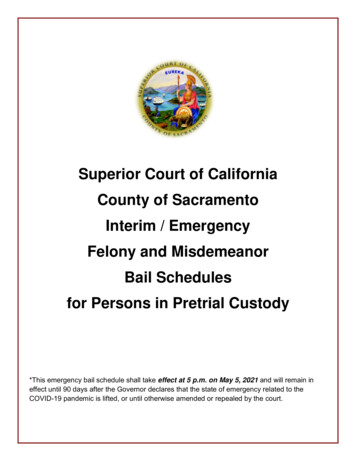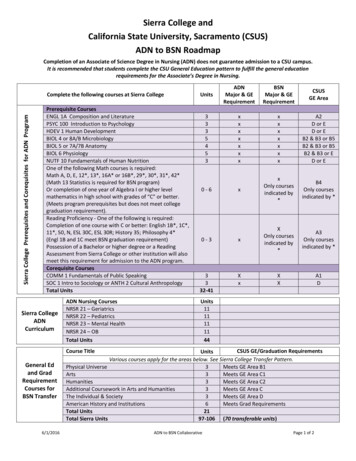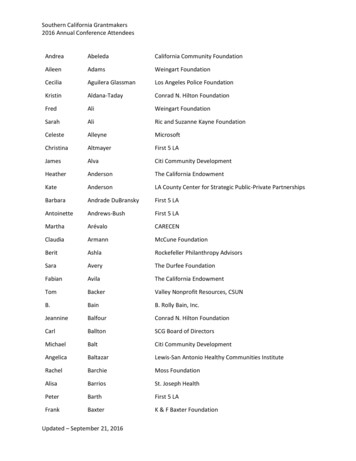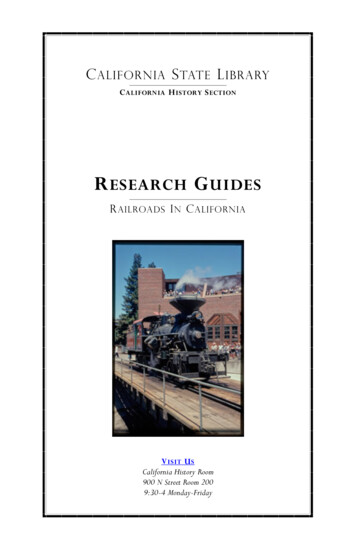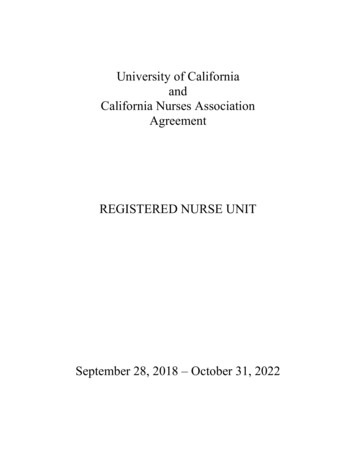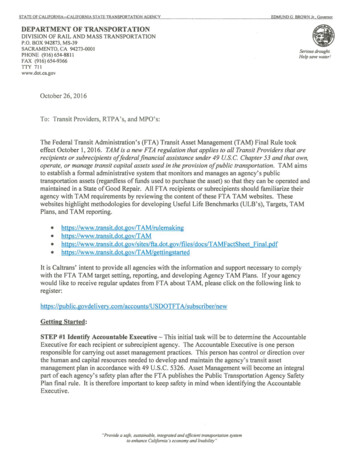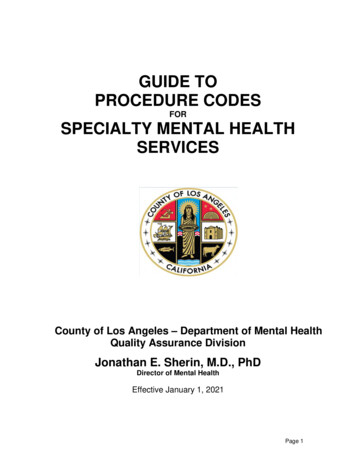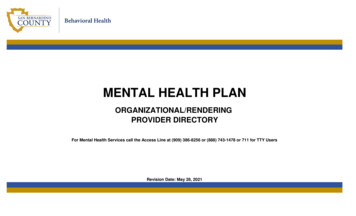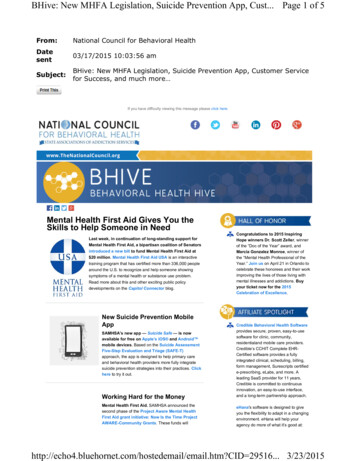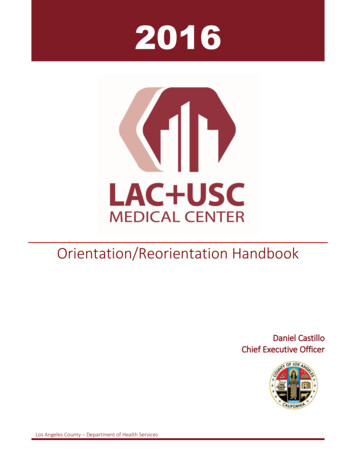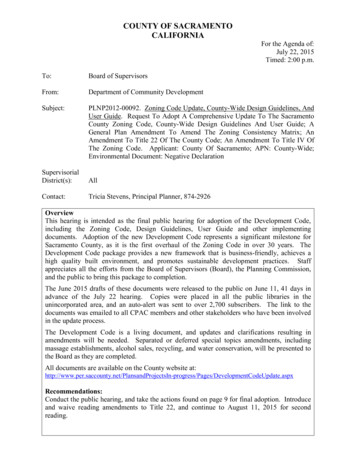
Transcription
COUNTY OF SACRAMENTOCALIFORNIAFor the Agenda of:July 22, 2015Timed: 2:00 p.m.To:Board of SupervisorsFrom:Department of Community DevelopmentSubject:PLNP2012-00092. Zoning Code Update, County-Wide Design Guidelines, AndUser Guide. Request To Adopt A Comprehensive Update To The SacramentoCounty Zoning Code, County-Wide Design Guidelines And User Guide; AGeneral Plan Amendment To Amend The Zoning Consistency Matrix; AnAmendment To Title 22 Of The County Code; An Amendment To Title IV OfThe Zoning Code. Applicant: County Of Sacramento; APN: County-Wide;Environmental Document: Negative cia Stevens, Principal Planner, 874-2926OverviewThis hearing is intended as the final public hearing for adoption of the Development Code,including the Zoning Code, Design Guidelines, User Guide and other implementingdocuments. Adoption of the new Development Code represents a significant milestone forSacramento County, as it is the first overhaul of the Zoning Code in over 30 years. TheDevelopment Code package provides a new framework that is business-friendly, achieves ahigh quality built environment, and promotes sustainable development practices. Staffappreciates all the efforts from the Board of Supervisors (Board), the Planning Commission,and the public to bring this package to completion.The June 2015 drafts of these documents were released to the public on June 11, 41 days inadvance of the July 22 hearing. Copies were placed in all the public libraries in theunincorporated area, and an auto-alert was sent to over 2,700 subscribers. The link to thedocuments was emailed to all CPAC members and other stakeholders who have been involvedin the update process.The Development Code is a living document, and updates and clarifications resulting inamendments will be needed. Separated or deferred special topics amendments, includingmassage establishments, alcohol sales, recycling, and water conservation, will be presented tothe Board as they are completed.All documents are available on the County website dations:Conduct the public hearing, and take the actions found on page 9 for final adoption. Introduceand waive reading amendments to Title 22, and continue to August 11, 2015 for secondreading.
PLNP2012-00092. Zoning Code Update, County-Wide Design Guidelines, And User Guide.Request To Adopt A Comprehensive Update To The Sacramento County Zoning Code, CountyWide Design Guidelines And User Guide; A General Plan Amendment To Amend The ZoningConsistency Matrix; An Amendment To Title 22 Of The County Code; An Amendment To TitleIV Of The Zoning Code.Applicant: County Of Sacramento; APN: County-Wide;Environmental Document: Negative DeclarationPage 2Measures/EvaluationApproval of the Development Code package will streamline the development process bysimplifying land use entitlements and reducing entitlement processing time, thereby promotingeconomic development. Approval will create a more user-friendly Zoning Code with clearerstandards and greater flexibility, and will implement General Plan policies which promotemixed-use and sustainable development practices.Fiscal ImpactCosts for the Zoning Code Update have been included in the Fiscal Year 2014-15 AdoptedBudget and Fiscal Year 2015-16 Recommended Budget.BACKGROUNDThe Board conducted a series of workshops and public hearings on the Development Code,including the Zoning Code, Design Guidelines, and the User Guide, from October 2014 to May2015. July 22, 2015, is targeted as the final public hearing for adoption of the package.The June 2015 draft of the Development Code package was released on June 11, 2015. Thisdraft shows changes from the August 2014 draft in bold and strikeout. Icons are used to explainthe types of changes in the document, which fall under three categories:Changes directed by the Board at various workshops and hearings and included in theBoard staff reports. Attachment 1 provides a summary of changes directed by the Board.Minor modifications and clarifications from the following sources: Clarifications stemming from Board or public comments as found in the Master Listof Comments. Minor adjustments noted by staff during final review, including the addition of crossreferences and deletion of redundancies or inconsistencies. Addition of subsections or sentences that are included in the current Zoning Code andinadvertently left out of the new Code. Clarifications from other agencies, including the Environmental ManagementDepartment.Formatting changes mostly in the form of moving sections to more appropriate locationsin the document. The substance of the section did not change.List of comments since May 6, 2015, and Revision Sheet. Attachment 2 provides a list ofcomments since the May 6 hearing, along with staff responses, resulting in revised language (seeRevision Sheet, Attachment 3) which will become part of the final action and then incorporatedinto the adopted version.Planning Commission comments. The County Planning Commission requested a report back oncomments made at prior workshops. A report back was provided on June 22, 2015.
PLNP2012-00092. Zoning Code Update, County-Wide Design Guidelines, And User Guide.Request To Adopt A Comprehensive Update To The Sacramento County Zoning Code, CountyWide Design Guidelines And User Guide; A General Plan Amendment To Amend The ZoningConsistency Matrix; An Amendment To Title 22 Of The County Code; An Amendment To TitleIV Of The Zoning Code.Applicant: County Of Sacramento; APN: County-Wide;Environmental Document: Negative DeclarationPage 3Commissioner Von Ommering posed questions relating to crowing fowl and water conservation.Commissioner Reiners proposed to add a RD-6 zone, as described below.DISCUSSIONFollow-up on Items from the May 6, 2015 Board HearingAt the May 6, 2015, hearing, the Board gave general direction on the definition of a dwellingunit and a single household unit, and the non-conforming status of dwellings that no longer meetthe definition. In addition to the language on conversion of a dwelling to more than fourbedrooms, staff recommends the following provisions that address this topic. These provisionsfocus on the physical arrangement of the dwelling. Sober living facilities are not classifiedseparately, and would only be affected if configured as a facility not meeting the definition of adwelling unit. This section provides a report back on sober living facilities.Definition of Dwelling Unit. The definition of a dwelling unit is expanded to provide moredirection on what constitutes a single household unit, as follows (bold is new language):A dwelling unit shall mean one or more rooms in a dwelling, apartment house or apartmenthotel designed for or occupied by one family persons residing together in a singlehousehold for living or sleeping purposes and having only one kitchen and separate toiletfacilities. A single household means that the occupants of a dwelling unit haveestablished ties and familiarity with each other, jointly use common areas, interact witheach other, share meals, household activities, and expenses and responsibilities.Indications that a household is not operating as single household: members of thehousehold have separate, private entrances from other members; members of thehousehold have locks on their bedroom doors; members of the household have separatefood storage facilities, such as separate refrigerators.Non-Conforming Dwelling Units. The Board was concerned about the status of existingdwelling units that may not meet the new definition of a dwelling unit. Staff recommends thefollowing addition to the non-conforming language. The language below is excerpted from thedraft Zoning Code with strikethroughs for recommended changes different than what is in thedraft Code. When this language is in place, code enforcement staff will, after receipt of acomplaint, make a determination whether a dwelling unit conforms to this definition. Anapplication for a Certificate of Non-Conforming Use must be made if the dwelling unit does notconform to the current definition and existed prior to adoption of the Zoning Code. TheCertificate process involves review by surrounding property owners and the CPAC, and anynuisances are addressed.1.9.3.N.Non-Conforming Dwelling Units Used as BoardinghousesExisting structures in residential zoning districts that do not meet the currentdefinition of a dwelling unit and meet the current definition of a boardinghouseare considered non-conforming uses. Within one year of the date of adoption ofthis Code, such use shall comply with the Zoning Code in effect or obtain aCertificate of Non-Conforming Use pursuant to Section 1.9.3.E and Section 6.5.2.
PLNP2012-00092. Zoning Code Update, County-Wide Design Guidelines, And User Guide.Request To Adopt A Comprehensive Update To The Sacramento County Zoning Code, CountyWide Design Guidelines And User Guide; A General Plan Amendment To Amend The ZoningConsistency Matrix; An Amendment To Title 22 Of The County Code; An Amendment To TitleIV Of The Zoning Code.Applicant: County Of Sacramento; APN: County-Wide;Environmental Document: Negative DeclarationPage 4The application shall be referred to the appropriate Community PlanningAdvisory Council and noticed to property owners within a 500-foot radius of theproperty line.Findings for Issuance of a Certificate of Non-Conforming Use. The following finding for theissuance of a Certificate of Non-Conforming Use for a non-compliant dwelling unit is added inorder to insure that consideration is given to persons with disabilities.6.5.2.C.Decision Authority and Approval Criteria1.The planning director shall be the appropriate authority to review and decide allapplications for the certificate of nonconforming use.2.For applications involving a non-conforming dwelling unit used as aboardinghouse, the planning director shall consider reasonableaccommodation for persons with disabilities consistent with federal andstate fair housing laws. Such housing shall be used by individualsprotected under federal and state fair housing laws and the accommodationis necessary to make specific housing available to protected individuals.Requirements for dwellings with more than four bedrooms. The conversion of homes to morethan four bedrooms requires a minor use permit. For either new or converted homes with morethan four bedrooms, the following standards are recommended.5.4.2.I.Special Requirements for Dwellings with More Than Four (4) BedroomsFor new homes or conversions of existing homes with more than four bedrooms,the following special requirements shall apply:1. Two additional off-street parking spaces for a total of four spaces.2. Any garage conversions shall be replaced with permanent enclosed parking.Definition of a bedroom. Staff has identified a potential challenge with the definition ofbedrooms in that it is possible to propose additions or conversions that involve rooms withoutclosets that could later be converted to sleeping rooms, especially with many closet systemsavailable on the market. The Building Code classifies any room with a closet as a bedroom, buta room without a closet can be labeled a den, family room, or storage. Thus, staff recommendsthe following definitions be added to the Zoning Code. A room designated as a den, study orfamily room, would have no door and one wall partially open in order to not be designated as abedroom.Bedroom. Any room in a dwelling unit used or intended or designed to be used forsleeping purposes with no less than 70 square feet of floor area and no dimension lessthan 7 feet other than bathroom(s), kitchen, living, dining, family or any other room thatmeets the definition of a den.Den (or family room, sewing room, study, loft studio or similar rooms). A roomwhich is open (has no door and has one wall that is at least 50 percent open to the interiorportion of the dwelling) or at least one side, does not contain a wardrobe, closet or similarfacility, and which is not designed or use for sleeping purposes.
PLNP2012-00092. Zoning Code Update, County-Wide Design Guidelines, And User Guide.Request To Adopt A Comprehensive Update To The Sacramento County Zoning Code, CountyWide Design Guidelines And User Guide; A General Plan Amendment To Amend The ZoningConsistency Matrix; An Amendment To Title 22 Of The County Code; An Amendment To TitleIV Of The Zoning Code.Applicant: County Of Sacramento; APN: County-Wide;Environmental Document: Negative DeclarationPage 5Findings for the issuance of a minor use permit for conversions. In order to insure thatconversions of homes over four bedrooms remain as a single-family dwelling, the followingfinding is added:6.4.2.C.2.a. Conversions of single-family dwelling to more than four bedrooms. Findingsshall be made that the floor plan is clearly not intended to maximize thepotential use of the property for rental purposes in a boardinghouseconfiguration as opposed to floor plan layouts typical of single-familydwellings, and that the conversion would not substantially change the floorplan in a manner that consists of predominately bedrooms with minimalcommon usable area. Findings shall also be made that adequate parking isprovided, in addition to the minimum requirements in Section 5.4.2.I.Sober living facilities. The Board requested a report back on sober living facilities and how theyrelate to licensed treatment and care facilities. Sober living facilities are homes where personsrecovering from alcohol or drug addictions live together as a step in their recovery. Sober livinghomes are not licensed by any state or local agency if they do not provide care, treatment,individual or group counseling, case management, medication management, treatment planning,or supervision of daily activities. Based on existing case law (as long as the home functions as asingle household unit), a sober living home is considered a dwelling unit.Treatment facilities include alcohol and drug treatment facilities licensed by the StateDepartment of Alcohol and Drugs and residential care facilities licensed by the State Departmentof Social Services. Five alcohol and drug treatment centers are licensed in the unincorporatedarea (see list in Attachment 4). There are 61 licensed residential care facilities with more thansix persons, including care homes for elderly, disabled, and youth. These residential carefacilities may house persons recovering from alcohol and drug addictions where supervision andsupportive services are necessary, but treatment is not provided. (See list in Attachment 5.)Since the State recently changed its practice of inspecting licensed facilities annually to everyfive years, these residential care facilities will no longer be exempt from the County’sResidential Housing Inspection Program (RHIP). Any facility that is not inspected annually byanother government agency will be required to register for RHIP and be subject to annualinspections, to insure compliance with housing and nuisance codes.The California Consortium of Addiction Programs and Professions (CCAPP) provides education,training, certification and registration for individuals and organizations involved in the treatmentof persons with alcohol and drug addictions. As one facet of an overall program, CCAPP hasstandards and voluntary registration for sober living environments, which are not otherwiselicensed by the State as a treatment facility. The registration is typically mandatory for any stateor local facility that receives grant funding, but is voluntary if no government funds are received.The standards cover management, record keeping, house rules and residency requirements. Fivehomes are registered with CCAPP in the unincorporated area, including some (not all) homesoperated by the “Clean and Sober Transitional Living” organization. Information is not availableon the number of unregistered sober living homes.At CPAC, Planning Commission and Board meetings on the Zoning Code update, severalindividuals have testified expressing concerns about sober living homes in their neighborhoods,
PLNP2012-00092. Zoning Code Update, County-Wide Design Guidelines, And User Guide.Request To Adopt A Comprehensive Update To The Sacramento County Zoning Code, CountyWide Design Guidelines And User Guide; A General Plan Amendment To Amend The ZoningConsistency Matrix; An Amendment To Title 22 Of The County Code; An Amendment To TitleIV Of The Zoning Code.Applicant: County Of Sacramento; APN: County-Wide;Environmental Document: Negative DeclarationPage 6in particular the homes on Marwick Way in Carmichael and Shawnee Avenue in Fair Oaks. TheMarwick Way home is operated by “Clean and Sober Transitional Living” and it is not knownwhether if it is registered by CCAPP. The home on Shawnee Avenue is operated by “Steps toFreedom” and houses 22-29 persons, and is not on the registration list.Nuisances reported by neighbors on Marwick Way include: loitering in the front yard, increasedvehicle and pedestrian traffic of unknown persons associated with the home, increase in theamount of trash on the street, drug paraphernalia on neighbors’ yards, loud profanity andarguments, and persons trespassing and rummaging in garbage cans (see Attachment 6a).Neighbors on Shawnee Avenue indicate that there is an increase of traffic and residents stay late,and park in front of houses in the neighborhood. There are times when there are as many as 10cars on the street. They are concerned about maintenance of the home and compliance withwatering restrictions, and with potential crime (Attachment 6b).A number of cities have permitted sober living homes with limitations by classifying them as agroup home instead of a single-family home. In most cases, the courts have found suchordinances invalid on the basis that they are discriminatory towards persons with disabilities.The City of Costa Mesa adopted an ordinance after extensive documentation of nuisancesresulting from overconcentration of sober living homes. Their ordinance limits grouphomes/sober living homes to six or fewer persons (plus an on-site manager) and requires thatthey be located 660 feet apart. This ordinance is being challenged in the courts and manycommunities are awaiting the outcome to determine if the legal framework will change.The proposed Sacramento County ordinance focuses on regulating physical premises and thedefinition of a single household unit. In addition to the Code amendments, staff isrecommending two strategies to address nuisances associated with dwellings with multiple rentalagreements, including potentially sober living homes: Require a business license for the rental of properties for landlords that enter into more thantwo rental agreements. This requirement would capture the rental of homes when there aremultiple rentals in one dwelling, or when a landlord has more than two rental homes eachwith a single agreement. Conditions on the business license may address nuisances such asparking and noise. Establish a cooperative relationship with CCAPP to promote registration through CCAPPand to assist in mediating sober living facilities that are not following good neighborpractices, such as controlling noise and loitering.Comments since May 6, 2015Below is a summary of key public comments made since the May 6, 2015, Board hearing, withstaff responses. Attachment 2 provides a list of all comments and responses. When the June,2015, draft was released to the public, comments were requested by July 11, 2015, in order to beincluded in the Board report. An addendum will be prepared to respond to any commentsreceived after the release of this report prior to the hearing.Setbacks for keeping of animals. Two comment letters were received regarding setbacks forpens/corrals: a) letter from two members of the Southeast (SE) CPAC (Tim Reinarts and Tina
PLNP2012-00092. Zoning Code Update, Co
Adoption of the new Development Code represents a significant milestone for Sacramento County, as it is the first overhaul of the Zoning Code in over 30 years. The . The Development Code is a living document, and updates and clarifications resulting in . This section provides a report back on sober living
